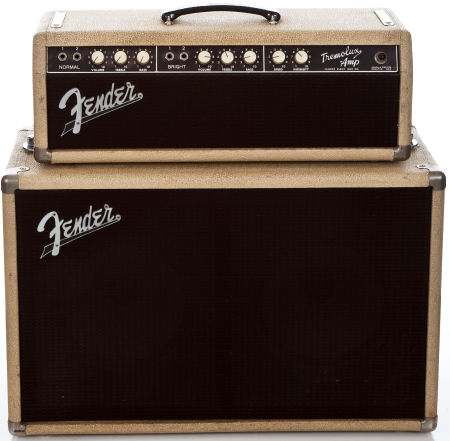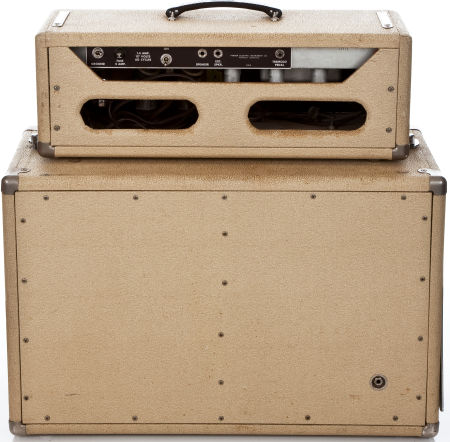Fender Blonde Tremolux
Model/Circuit Number: 6G9, 6G9-A, 6G9-B
Years of Production: 1961 – 1963
Era: Blonde
Configuration: Piggyback
Controls: Brown forward facing w/ white labels, controls numbered 1 – 10
Knobs: White round, unnumbered
Schematics
Faceplate
- Front: Bright: In, In, Vol, Treb, Bass – Normal: In, In, Vol, Treb, Bass – Speed, Intensity – Pilot Lamp
- Rear: Ground Sw, Fuse (2A), Power Sw, Speaker Jack, Ex. Speaker Jack, Tremolo Jack
Cabinet
- Dimensions: Head: 8 x 23 x 8 3/8, Cabinet: 17½ x 27 x 11½
- Hardware: Medium Chassis Straps 4 5/8”
- Handle: Brown plastic Strap
- Feet: Glides
- Corners: Corner Protectors
Covering Material
- Tolex/Tweed: White Tolex
- Grill Cloth: Maroon (61-62) or wheat (62-63) grill cloth
Logo: Grill mounted, flat, chrome & black, script
Weight:
Speaker
- Size: 6G9, 6G9-A: ported tone ring, 1 x 10”/8 ohms 6G9-B: sealed, 2 x 10/4 ohms (8 ohms each in parallel)
- Impedance: 8 ohms ; 4 ohms
- Model: Jensen P10Q or Oxford 10K5(For more info, check out the Jensen Replacement Speakers)
Effects: Tremolo
~Watts: 30-35 watts
Tubes
- Pre amp: 7025
- Power: 6G9: 2 x 6BQ5 ; 6G9-A, 6G9-B: 2 x 6L6GC
Bias: Fixed Bias, Nonadjustable
Rectifier: GZ34
Comments: Some early Tremolux cabs were fitted with a 1 x 12″ baffle.



This is actually a blackface recovered in blond.
No presence control.
Thanks for the comment! Would you happen to know where i could get a real photo of the blonde version?
Barry.Will a pic of a brown face blonde tolex marron/oxblood grill export version do ? Fully stripped down at the mo pending a service.
I’ll email you a photo of mine if you like. which detail are you looking for?
Front / Back / Inside
Do you have the tilt leg, hole location dimensions for the Tremolux cabinet?
Thanks,
Do you have the tilt back leg hole placement dimensions for a Tremolux cabinet? Thanks,
Barry – sorry, but your mistaken. The photo is correct…a 1961 Tremolux. Easy mistake though… The picture here is a 1961 6G9, using two 6BQ5 tubes. Only made one year. Check your schematic. The 6BQ5 6G9 circuit did NOT have a presence control.
My ’62 6G9-B has no standby switch…
How can I figure out which circuit number I have? And how can I verify that I have a ’62? Thanks, Ed.
You can probably remove your chassis and find some information somewhere on the underside.
None of the Tremolux Piggy backs used a presence control. You are thinking of a Bassman.
The 6G9 uses 2 – 6BQ5 power tubes, and does have a standby switch.
The 6G9-B uses 2 – 6L6 tubes, and does not have a standby switch.
Blackface uses 2 – 6L6, with standby.
Fee free to call Lightning Music with questions; 614-746-8631
Mine has a standby switch, and 6L6’s, and a tone ring cabinet. There is no tube chart. But with vintage Fender, anything is possible.
The 6G9 has no tube chart, I have one and the reason for the lack of a tube chart I uncovered in my research is that as Fender only made 150-175 of these amps (starting with serial number 00175 the highest serial number recorded was 00325} consequently printing such a low volume of tube charts was a decision Fender chose against. What they did was mimeograph the required number of charts and paste them in with mucilage. Mimeographs fade to invisible within a year or so and mucilage dries out and whatever was pasted on with it falls off. As the amp is 60 years old finding a tube chart intact would be miraculous, if a 6G9 appears with a printed tube chart intact be suspicious.
Do you have the tilt back leg hole placement dimensions for a Tremolux cabinet? Thanks,
I have a JD Newell reproduction cab of the earlier 6G9-A 2 x 10″ which is smaller than the later 6G9-B 2 x 10″
14″ legs
Pivot screws: 12 3/8″ from the bottom, 2 3/8″ from the back
Stop screws: 14″ from the bottom, 4 3/4″ from the back
No need to post multiple times. Your first post gets noticed. ;^)
To Barry, none of the versions of the 6G9 Tremolux have a Presence control. I have owned a 6G9B and currently own a 6G9A with tone ring cab and neither of them had a presence control. Only the higher powered models during the 1960-63 6G type Fender Blond/Brown amps have a presence control(Bandmaster, Bassman, Pro, Super, Showman, Twin & Vibrasonic would be the models). Any Fender 6G era amp specified below 35 watts does not have a presence control. For those that care, the 6G9A Tremolux is the same amp as the 6G11 Vibrolux combo.
I have a vintage Tremolux 2×10″ cabinet that has been ‘reworked’. Were these cabinets totally sealed, or did they have porting holes in the baffle? Also, if sealed, did they originally have fill material, and what type?
Part of this is from my own observations and some from other, knowledgeable sources. Verifications or corrections are welcome.
There were two sizes of 2 x 10″ sealed cabs for the 6G9 heads.
The earlier cab is generally 26″ or 27″ wide and has no center baffle. It has dimensions identical to the 10″ tone ring cab. A few early cabs have been seen with a shallow center baffle that doesn’t reach to the back panel. It seems to be a baffle board stiffener more than a baffle. The later cab is generally 28″ wide and has a center baffle, ported between chambers at its lower edge. The dimensions of the cab are identical to the cabs for the later AA763 amp. Examples of both sizes have varied +/- 1/2″ and even 1″ in any dimension.
It’s often stated that the 2 x 10″ was introduced with the 6G9-B, but actually the smaller 2 x 10″ was available at some point during the run of 6G9-A heads. The 2 x 10″ cabs came out of the factory with fiberglass batts on the sides only, fiberglass filling all space, or absolutely nothing. If there was a standard, it wasn’t enforced.
The 2-10 cabs are sealed the 1-10″ tone ring cab had the “floating Baffle” so it is ported around the edges.
My 6G9 (no A or B) was 00845 KK on tube chart Factory installed 5881 and also a JBl D120 12″. Before whoever took over this site, my amp was the one posted here (since 1996) with the dusty rose colored wall behind it.
Does anyone know if any tremolux 6g9-a early 1961 were produced in brown tolex
We’re there any tremolux produced in brown in 1961
We’re there any 1961 tremolux produced in brown tolex
I recently obtained a ’62 brown face Tremolux head. Some one had re-tolex black and silver grill cloth.
The stamp is still in place and indicates year L (1962) and maybe an H or A for the month…
When in 1962 did Fender begin to use cream/wheat combo instead of the Oxblood?
Any experts out there? I realize it may be indeterminant.
Thanks
No Piggy-back amp was made in a Brown Tolex version. Temoluxes were covered as follows:
60-63 Rough Blonde Tolex, 64 Smooth Blonde Tolex or Black Tolex, 64-66 Black Tolex only.
Has anyone seen or heard of an early ’63 Brown face covered in Black telex? This amp looks really original, but it is a brown face w/ white knobs and black telex. It doesn’t appear to be a re-cover but thats hard to tell.
Thanks.
An early ’63 is almost certainly recoverd. Generally, Fender used a given type of Tolex until they ran out of it. There was often an inteim period where two types were being used at once. There are plenty of ’64 black panel AA763 Tremolux amps and cabs that are in original blonde Tolex.
i have fender tremolux chassis#04488,pentened 005 tube chart6l6,stamp, (something), A,oxblood front, 2×10’s, ,could you tell me what year, it sold to me 1962 ?. lhave to sell, due to a deep stroke. anything info will be appreciate
l just sent you e mail, wrong spelling my address zak37@sympatico. ca
Technicaly does it matter ?…….possibly the most fearless amp ever built ?
Thanks for all the comments, Gentlemen … All I know is, I would love to own an early ’60s Tremolux … I remember seeing and hearing them when they were brand new and have always wanted one. I guess I will be relegated to having a head built and adding a custom-built cabinet to, it as I am able. Any of you guys who have a Tremo are extra lucky people … actually, extra blessed of God. Good for you! Enjoy!
I have a 1962 Tremolux that I’d like to sell
An overlooked fact that I have never seen addressed anywhere, and is what I have come to believe anyway, because of the 6G9 pictures and Fender’s own schematics and layouts is that the first ones had the Bright channel first and the Normal channel second and later the opposite when looking at the amp from the front.
My 6G9-B model has the latter. I’m not sure about which models got what, but they definitely had both faceplates set up that way. Check them out. I didn’t notice it until I compared schematics and started looking at actual pictures of the amps closely.
Another thing is the layouts and schematics that are here on this page.
There is no layout for the original 6G9 showing 6BQ5’s.
Fender made them, I have one.
Look closely at the 6G9 layout which is different from the 6G9 schematic, it has 6L6s and read what it says at the bottom left, *Revision for converting from 6BQ5s to 6L6s*.
I accidentally ran across all of this confusion when I was working on my 6G9-B converting it to the first 6G9 years ago. I had the chassis only and it had burned transformers in it and I thought, what the heck, I’ll convert it back to the original. The voltages are too high today like they were back in ‘61 even with Mercury tone clone transformers, and I’m sure that is why they changed the circuit.
It’s a very cool sounding amp but I don’t play it much and that’s probably the reason that it hasn’t smoked on me.
I’ll probably convert it back to to its B model birth one of these days, Good Lord willing. I don’t want those expensive Mercury transformers to go up in smoke either.
My ears can’t really appreciate much difference in it and my 66 blackface Tremolux, except being brighter, but that’s just me of course.
Tip for anyone who has a 6G9 that still has the 6BQ5’s and original transformers in it: only fire it up on a variac, at no more than 100v. Line voltage is higher today (120-125v) than it was when these amps were new (105v-110v). When the amps were new, they tended to burn up tubes, speakers, and the transformers caught on fire. Run at 100v (or even 90v) and you should avoid those fates. They’ll sound better, too!